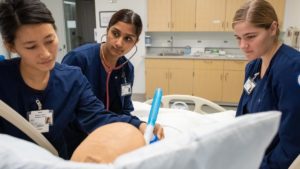Video produced by Sawyer D. Schultz
The Margaret A. Cargill Natural Sciences and Health Building

Classrooms

Classrooms in the Cargill Building are similar to those in the Grove City College STEM Hall built by Ballinger. The glass walls put science on display, inviting students, especially non-majors, into the classroom space thereby familiarizing them with work in the sciences. By encouraging all students to engage with the sciences, the College hopes to better prepare its students for careers in and out of the sciences. Putting science on display facilitates discussions across the discipline and enrich the total educational experience.
Anatomy and Physiology Lab

The learning space is designed with bench pods that students (32) and instructors can easily move between to facilitate interaction. The associated cadaver storage area allows for the best pedagogical practices in the study of human anatomy. Having the ability to store and use cadavers also provides opportunities to create a new human anatomy course designed to prepare pre-medical students for gross anatomy required in medical school.
Clinical Skills Lab
The clinical skills lab offers a realistic setting for nursing students of all levels to learn and practice essential skills. It is equipped with modern patient-care technology, so students learn how to use equipment in a safe setting prior to being expected to demonstrate competence in a clinical setting.
Nursing Simulation Labs

There are two simulation labs, one devoted to teaching care of patients with a variety of medical-surgical and intensive/coronary care problems. This simulation lab prepares students for managing and providing care to clients with acute, chronic, or life-threatening physical health conditions using a high-fidelity adult simulator including software for immediate debriefing capabilities. The high-fidelity simulator enables students to assess and manage patient problems with airway, breathing, heart, and circulation compromise.
The second simulation lab is devoted to caring for pediatric and maternity patients. The lab is equipped with high-fidelity birthing and pediatric manikins, so students can learn essential competencies in both head trauma and asthma which are common childhood problems.